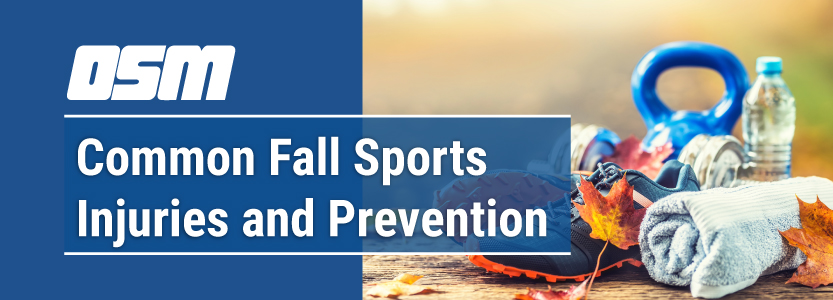Common Fall Sports Injuries (And How to Prevent Them)
Article featured on Towson Orthopaedic Associates
When the crisp autumn air cuts through the dog days of summer, runners are on their mark. The fall season starts many high-intensity sports for teens and adults, which means injuries can increase when coming off of a break. Practicing good habits like stretching can prevent injuries so you can get ready, get set, and go with your favorite sport this fall.
Fall Season Sports
Many fall sports have running at their core. Football, soccer, and cross country running come to mind. But sports like tennis, lacrosse, and volleyball also require strong, repetitive motion. Strength and cardiovascular training are essential to success and safety in any sport.
Typical Sports from September to November:
- Football
- Field Hockey
- Lacrosse
- Soccer
- Cross Country Running
- Cheerleading
- Volleyball
- Tennis
- Golf
Common Fall Sports Injuries
All types of sports and athletic activities come with an increased risk of injury. Typical injuries include leg injuries, knee injuries, arm injuries, shoulder injuries, and head injuries. The most common injuries are:
A Concussion is a brain injury that can occur in any sport, but is more common in contact sports—such as football or field hockey—and in sports like soccer where the head is used in play. Any blows to the head should be taken seriously to prevent a more serious head injury. Learn to recognize the following signs of concussion:
- Headache
- Nausea or vomiting
- Ringing in the ears
- Head or eye pain when exposed to bright lights
- Confusion
- Fatigue
Playing through a concussion can lead to more serious injury and prolonged symptoms which can negatively impact mental state and abilities.
Fractures are bone breaks that require immediate medical attention. There are many different types of fractures. These include:
- Open fractures
- Comminuted fracture
- Complete fracture
- Greenstick fracture
Strains occur from a sudden awkward movement or overuse of a muscle in the upper and lower body. Muscle strain can affect both novice and experienced athletes. Exerting a strained muscle can worsen the injury. Recognize these symptoms of a strain to take a time out:
- Swelling
- Cramping
- Stiffness
- Feeling a “Pop”
Sprains are partial or complete tears of a ligament within a joint and most commonly occur in the ankle, wrist, or knee. Most are minor injuries, however, an anterior cruciate ligament—or ACL tear—is a common injury that affects the ligament that stabilizes the knee. It is a severe injury that requires rehabilitation and/or surgery. Signs of a sprain include:
- A popping sound during injury
- Swelling or bruising
- Pain in the area
- Difficulty walking or limited range of motion
Strains and sprains are similar injuries that are treated with PRICE, an acronym for the treatment protocol of: Protection, Rest, Ice, Compression, and Elevation. Minor sprains should respond to PRICE and an anti-inflammatory painkiller.
Shin Splints are overuse injuries that commonly afflict runners. It is an injury of the soft tissue that holds the muscle to the bone and is caused by a rapid increase in intensity or frequency of running, improper shoes, or occasional flat feet.. Shin splints can occur with any sport that involves strenuous running, like soccer or field hockey. To prevent shin splints, stretch before any physical activity and make sure to get plenty of rest between active sessions. Replace your shoes at regular intervals—for runner’s, that is every 300-500 miles.
Patellofemoral syndrome, commonly known as runner’s knee, is a knee injury that causes pain when the cartilage in the kneecap becomes irritated. Repetitive squatting or crouching motions, like those used in volleyball. Treatment for runner’s knee typically includes the PRICE method, kinesiology taping or bracing, and physical therapy focused on strengthening the core, knee, and surrounding muscle groups.
Preventing Sports Injuries
Being aware of what kinds of injuries to expect in the fall sports season makes sports injury prevention easier.
This simple checklist can help to prevent injury in any sport:
- Get a physical before the active season
- Stretch and warm up
- Crosstrain to strengthen all muscle groups
- Make sure the playing field is maintained
- Invest in good protective equipment like proper footwear
- Fuel your body
- Speak up about pain
- Rest after injury
- Enjoy downtime
Following these injury prevention tips can prepare the body for strenuous activity and keep you off the bench this season. Remember, getting back into the swing of things this autumn doesn’t have to be a drag.
The Orthopedic & Sports Medicine Center of Oregon is an award-winning, board-certified orthopedic group located in downtown Portland Oregon. We utilize both surgical and nonsurgical means to treat musculoskeletal trauma, spine diseases, foot and ankle conditions, sports injuries, degenerative diseases, infections, tumors and congenital disorders.
Our mission is to return our patients back to pain-free mobility and full strength as quickly and painlessly as possible using both surgical and non-surgical orthopedic procedures.
Our expert physicians provide leading-edge, comprehensive care in the diagnosis and treatment of orthopedic conditions, including total joint replacement and sports medicine. We apply the latest state-of-the-art techniques in order to return our patients to their active lifestyle.
If you’re looking for compassionate, expert orthopedic and podiatric surgeons in Portland Oregon, contact OSM today.
Phone:
Address
17355 Lower Boones Ferry Rd Suite 100A
Lake Oswego, OR 97035
Hours
Monday–Friday
8:00am – 4:30pm



